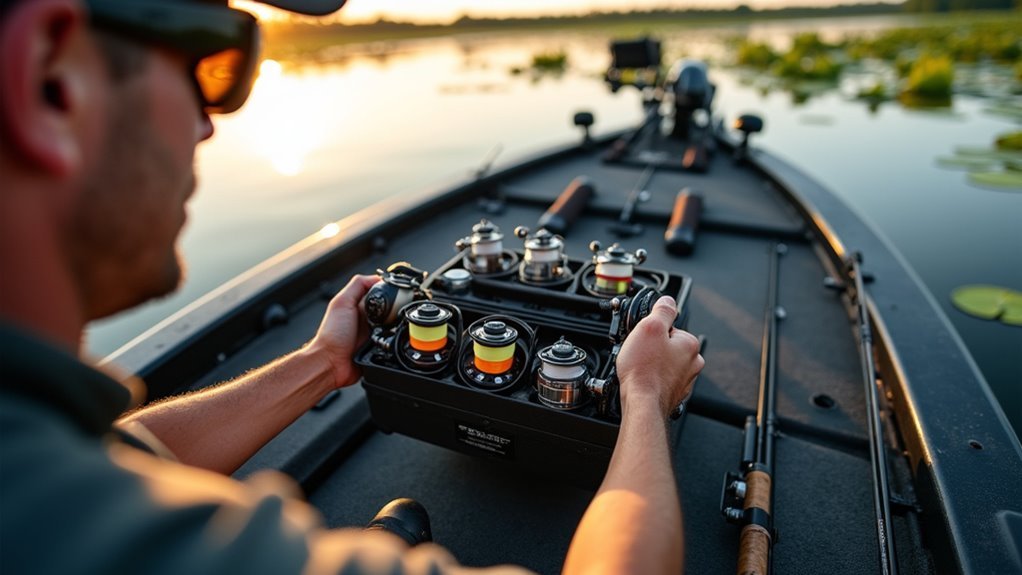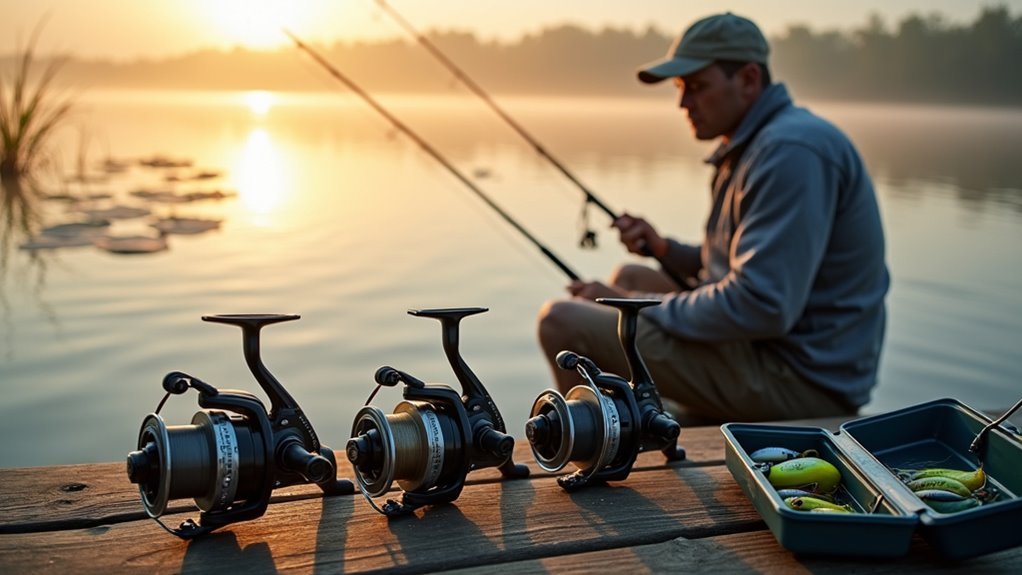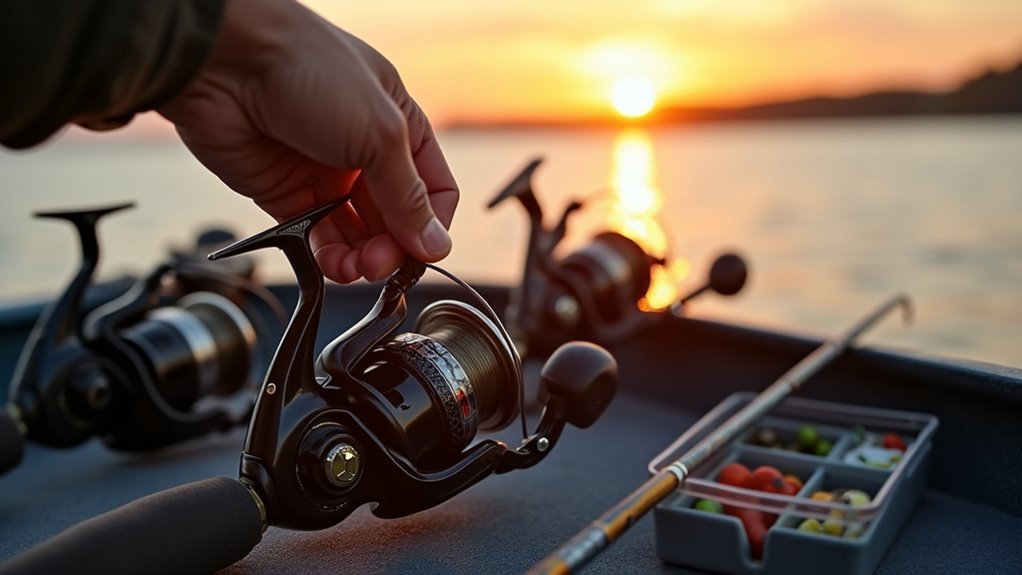When it comes to bass fishing, we’ve found that gear ratios aren’t one-size-fits-all. For beginners, a versatile 6:1 reel handles most situations perfectly. Match your ratio to your technique: slower 5:1-6:1 for crankbaits, zippy 7:1-8:1 for spinnerbaits, and 8:1+ for soft plastics. Water conditions matter too—slower in cold or muddy water, faster in warm or clear water. Our three-reel strategy will revolutionize your approach on the water.
The Science Behind Fishing Reel Gear Ratios

When we’re standing on the shore deciding which reel to use, most of us don’t think about the physics at work inside our fishing gear. But that little number on your reel—say 6:1 or 8.3:1—makes all the difference in your fishing success.
Simply put, gear ratio tells us how many times your spool rotates with one turn of the handle. A 7:1 ratio? That’s seven complete spool rotations per handle turn. It’s like choosing between a sports car and a truck—each has its perfect application on the water.
Matching Gear Ratios to Your Bass Fishing Techniques

As you’re rigging up for a day on the water, choosing the right gear ratio isn’t just about personal preference—it’s about giving your lures the perfect action to fool those finicky bass.
| Technique | Recommended Ratio | Why It Works | Our Experience |
|---|---|---|---|
| Crankbaits | 5:1 – 6:1 | Slows presentation, adds power | Landed a 7-pounder on a thorough exploration last summer |
| Spinnerbaits | 7:1 – 8:1 | Quick retrieval for reaction strikes | Works magic during dawn feeding frenzies |
| Topwater | 6:1 – 10:1 | Varies by bait type | Nothing beats a buzzbait explosion on 10:1 |
| Soft Plastics | 8:1+ | Fast slack pickup when they bite | Saved many hooksets with higher speeds |
Gear Ratio Selection for Different Water Conditions

The water conditions you’re fishing in dramatically impact which gear ratio will serve you best on any given day. In cold water, slower 5:1 ratios shine because bass are sluggish and prefer a methodical presentation. I’ve caught more winter lunkers by slowing down my retrieve than by rushing things.
For summer’s warm waters, bump up to 7:1 or 8:1 ratios. Bass metabolism increases with temperature, making them more likely to chase faster-moving lures. In muddy water, slower retrieves help fish locate your bait, while clear water often calls for faster retrieves to trigger reaction strikes.
Essential Gear Ratio Recommendations for Beginners and Pros

If you’re just starting your bass fishing journey, choosing the right gear ratio doesn’t need to be complicated. We recommend beginners invest in a versatile 6:1 reel that handles most situations beautifully. I’ve landed countless bass with this middle-ground ratio when I was learning the ropes.
For pros looking to expand their arsenal, we suggest a three-reel approach: a 5:1 for crankbaits and deep diving lures, a 6:1-7:1 for everyday use, and an 8:1 for quick retrieves with topwater or when pitching into heavy cover. Trust me, this combination has saved many tournament days!
Frequently Asked Questions
How Does Line Capacity Affect Gear Ratio Performance?
We need to understand that line capacity doesn’t directly affect gear ratio performance. However, with higher gear ratios, we’ll retrieve more line per handle turn, potentially emptying or filling our spool more quickly.
Can Gear Ratios Impact Casting Distance or Accuracy?
We’ve found gear ratios don’t directly impact casting distance or accuracy. These are more influenced by reel design, spool size, and line type. Your casting technique matters more than the gear ratio itself.
Do Gear Ratios Affect Reel Durability or Maintenance Requirements?
Yes, higher gear ratios typically have more wear on internal components. We’ve found that faster reels (8:1+) often need more frequent maintenance than slower ones, as they contain smaller gears under greater stress.
Should Gear Ratios Change Based on Rod Power/Action?
Like a dancer matching steps with their partner, we should indeed match gear ratios with rod power/action. We’ll get better performance when pairing faster ratios with lighter, sensitive rods and slower ratios with heavier power rods.
How Do Handle Size or Shape Influence Gear Ratio Efficiency?
Handle size and shape don’t affect gear ratio itself, but they influence our reeling comfort and power application. Larger handles offer more torque for low-ratio reels, while smaller ones work well with high-speed retrieves.
Conclusion
We’ve cast our line through the depths of gear ratio wisdom, and now you’re equipped to reel in success on your next outing. Like finding the sweet spot on a bend in the river, choosing the right gear ratio balances art and science. Trust us—we’ve lost monsters and landed trophies because of these numbers! Pair your techniques with the perfect ratio, and you’ll be trading fish stories instead of the ones that got away.